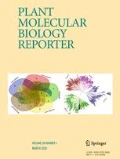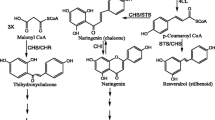Abstract
Plant lipoxygenases (LOXs) are functionally diverse class of dioxygenases involved in multiple physiological processes such as plant growth, biotic and abiotic stress responses, and secondary metabolite accumulation. In this paper, two LOX genes, TcLOX1 and TcLOX2, were cloned from Taxus chinensis cells. Multiple alignment of the deduced amino acid sequences with those of other plants demonstrated the putative LH2/PLAT domain, lipoxygenase iron-binding catalytic domain, lipoxygenase_1 and lipoxygenase_2 signature sequences. Phylogenetic analysis suggested that TcLOX1 and TcLOX2 putative proteins are most probably 9-LOXs, and shared the highest identity with the tea plant CsLOX1 and Picea sitchensis LOX genes, respectively. Semiquantitative RT-PCR analysis showed that TcLOX1 was preferentially expressed in stem and root, while TcLOX2 was preferentially expressed in root. Real-time quantitative PCR analysis showed that a strong upregulation of TcLOX1 was observed in response to methyl jasmonate and abscisic acid (ABA), while TcLOX2 was strongly upregulated by ABA. However, TcLOX1 and TcLOX2 were nearly not responding to salicylic acid. These data suggest both TcLOX1 and TcLOX2 play an important role in T. chinensis, and they are required in different physiological processes involved in different plant signals in vivo.





Similar content being viewed by others
Abbreviations
- MeJA:
-
Methyl jasmonate
- ABA:
-
Abscisic acid
- SA:
-
Salicylic acid
- RT-PCR:
-
Reverse transcriptase PCR
- Real-time Q-PCR:
-
Real-time quantitative PCR
References
Achnine L, Huhman DV, Farag MA, Sumner LW, Blount JW, Dixon R (2005) Genomics-based selection and functional characterization of triterpene glycosyltransferases from the model legume Medicago truncatula. Plant J 41:875–887
Bell E, Mullet JE (1991) Lipoxygenase gene expression is modulated in plants by water deficit, wounding, and methyl jasmonate. Mol Gen Genet 230:456–462
Bhardwaj PK, Kaur J, Sobti RC (2011) Lipoxygenase in Caragana jubata responds to low temperature, abscisic acid, methyl jasmonate and salicylic acid. Gene 483:49–53
Cipollini D, Enright S, Traw MB, Bergelson J (2004) Salicylic acid inhibits jasmonic acid-induced resistance of Arabidopsis thaliana to Spodoptera exigua. Mol Ecol 13:1643–1653
Ealing PM, Casey R (1988) The complete amino acid sequence of a pea (Pisum sativum) seed lipoxygenase predicted from a near full-length cDNA. Biochem J 253(3):915–918
Feussner I, Wasternack C (2002) The lipoxygenase pathway. Annu Rev Plant Biol 53:275–297
Feys BJ, Parker JE (2000) Interplay of signaling pathways in plant disease resistance. Trends Genet 16:449–455
Gális I, Šimek P, Narisawa T, Sasaki M, Horiguchi T, Fukuda H, Matsuoka K (2006) A novel R2R3 MYB transcription factor NtMYBJS1 is a methyl jasmonate-dependent regulator of phenylpropanoid-conjugate biosynthesis in tobacco. Plant J 46:573–592
Geourjon C, Deleage G (1995) SOPMA: significant improvements in protein secondary structure prediction by consensus prediction from multiple alignments. Bioinformatics 11:681–684
Glazebrook J (2005) Contrasting mechanisms of defense against biotrophic and necrotrophic pathogens. Annu Rev Phytopathol 43:205–227
Häkkinen ST, Tilleman S, Šwiątek A, Sutter VD, Rischer H, Vanhoutteb I, Onckelend HV, Hilson P, Inzé D, Oksman-Caldenteya KM, Goossens A (2007) Functional characterisation of genes involved in pyridine alkaloid biosynthesis in tobacco. Phytochemistry 68:2773–2785
Hildebrand DF (1989) Lipoxygenase. Physiol Plant 76:249–253
Hornung E, Walther M, Kuhn H, Feussner I (1999) Conversion of cucumber linoleate 13-lipoxygenase to a 9-lipoxygenating species by site-directed mutagenesis. Proc Natl Acad Sci U S A 96:4192–4197
Huang YF, Lan WZ, Chen C, Yu LJ (2004) Role of lipoxygenase in taxol production induced by elicitor in Taxus chinensis cell cultures. Process Biochem 40(8):2793–2797
Jung C (2007) Microarray-based screening of jasmonate-responsive genes in Arabidopsis thaliana. Plant Cell Rep 26:1053–1063
Liavonchanka A, Feussner I (2006) Lipoxygenases: occurrence, functions and catalysis. J Plant Physiol 163:348–357
Liu S, Han B (2010) Differential expression pattern of an acidic 9/13-lipoxygenase in flower opening and senescence and in leaf response to phloem feeders in the tea plant. BMC Plant Biol 10:228
Lu X, Lin XY, Shen Q, Zhang FY, Wang YY, Chen YF, Wang T, Wu SY, Tang KX (2011) Characterization of the jasmonate biosynthetic gene allene oxide cyclase in Artemisia annua L., source of the antimalarial drug artemisinin. Plant Mol Biol Rep 29:489–497
Meier BM, Shaw N, Slusarenko AJ (1993) Spatial and temporal accumulation of defense gene transcripts in bean (Phaseolus vulgaris) leaves in relation to bacteria-induced hypersensitive cell death. Mol Plant Microbe Interact 6:453–466
Melan MA, Dong X, Endara ME, Davis KR, Ausubel FM, Peterman TK (1993) An Arabidopsis thaliana lipoxygenase gene can be induced by pathogens, abscisic acid, and methyl jasmonate. Plant Physiol 101:441–450
Naoumkina M, Farag MA, Sumner LW, Tang Y, Liu C-J, Dixon RA (2007) Different mechanisms for phytoalexin induction by pathogen and wound signals in Medicago truncatula. Proc Natl Acad Sci U S A 104:17909–17915
Nemchenko A, Kunze S, Feussner I, Kolomiets M (2006) Duplicate maize 13-lipoxygenase genes are differentially regulated by circadian rhythm, cold stress, wounding, pathogen infection, and hormonal treatments. J Exp Bot 57:3767–3779
Pena-Cortes H, Albtrecht T, Prat S, Weiler WW, Willmitzer L (1993) Aspirin prevents wound-induced gene expression in tomato leaves by blocking jasmonic acid biosynthesis. Planta 191:123–128
Podolyan A, White J, Jordan B, Winefield C (2010) Identification of the lipoxygenase gene family from Vitis vinifera and biochemical characterisation of two 13-lipoxygenases expressed in grape berries of Sauvignon Blanc. Funct Plant Biol 37(8):767–784
Rischer H, Orešič M, Seppänen-Laakso T, Mikko K, Freya L, Diaz WA, Montagu MV, Inzé D, Oksman-Caldentey KM, Goossens A (2006) Gene-to-metabolite networks for terpenoid indole alkaloid biosynthesis in Catharanthus roseus cells. Proc Natl Acad Sci U S A 103:5614–5619
Royo J, Vancanneyt G, Perez AG, Sanz C, Stormann K, Rosahl S, Sanchez-Serrano JJ (1996) Characterization of three potato lipoxygenases with distinct enzymatic activities and different organ-specific and wound regulated expression patterns. J Biol Chem 271:21012–21019
Ryals J, Lawton KA, Delaney TP, Friedrich L, Kessmann H, Neuenschwander U, Uknes S, Vernooij B, Weymann K (1995) Signal transduction in systemic acquired resistance. Prog Nucl Acid Res 92:4202–4205
Santino A, De Paolis A, Gallo A, Quarta A, Casey R, Mita G (2003) Biochemical and molecular characterization of hazelnut (Corylus avellana) seed lipoxygenases. Eur J Biochem 270(21):4365–4375
Saravitz DM, Siedow JN (1996) The differential expression of wound-inducible lipoxygenase genes in soybean leaves. Plant Physiol 110:287–299
Shibata D, Steczko J, Dixon JE, Andrews PC, Hermodson M, Axelrod B (1988) Primary structure of soybean lipoxygenase L-2. J Biol Chem 263(14):6816–6821
Siedow JM (1991) Plant lipoxygenase: structure and function. Annu Rev Plant Mol Biol 42:145–188
Steczko J, Axelrod B (1992) Identification of the iron-binding histidine residues in soybean lipoxygenase L-1. Biochem Biophys Res Commun 186:686–689
Suzuki M, Yamaguchi S, Iida T, Hashimoto I, Teranishi H, Mizoguchi M, Yano F, Todoroki Y, Watanabe N, Yokoyama M (2003) Endogenous-ketol linolenic acid levels in short day-induced cotyledons are closely related to flower induction in Pharbitis nil. Plant Cell Physiol 44:35–43
Turner JG, Ellis C, Devoto A (2002) The jasmonate signal pathway. Plant Cell 14(Suppl):S153–S164
Yamaguchi S, Yokoyama M, Iida T, Okai M, Tanaka O, Takimoto A (2001) Identification of a component that induces flowering of Lemna among the reaction products of α-ketol linolenic acid (FIF) and norepinephrine. Plant Cell Physiol 42:1201–1209
Yokoyama M, Yamaguchi S, Inomata S, Komatsu K, Yoshida S, Iida T, Yokokawa Y, Yamaguchi M, Kaihara S, Takimoto A (2000) Stress induced factor involved in flower formation of Lemna is an α-ketol derivative of linolenic acid. Plant Cell Physiol 41:110–113
Zhang CH, Mei XG, Liu L, Yu LJ (2000) Enhanced paclitaxel production induced by the combination of elicitors in cell suspension cultures of Taxus chinensis. Biotechnol Lett 22:1561–1564
Zhao JT, Huang X, Chen YP, Chen YF, Huang XL (2009) Molecular cloning and characterization of an ortholog of NPR1 gene from Dongguan Dajiao (Musa spp. ABB). Plant Mol Biol Rep 27:243–249
Acknowledgments
This work was supported by National Natural Science Foundation of China (Grant 20906036, 20776058 and 201076093), National “11th Five-Year Plan” to Support Science and Technology Project of China (2008BAI63B04), and New Century Talents Support Program by the Ministry of Education of China in 2006.
Author information
Authors and Affiliations
Corresponding author
Additional information
Shu-tao Li and Meng Zhang contributed equally to this work.
Rights and permissions
About this article
Cite this article
Li, St., Zhang, M., Fu, Ch. et al. Molecular Cloning and Characterization of Two 9-Lipoxygenase Genes from Taxus chinensis . Plant Mol Biol Rep 30, 1283–1290 (2012). https://doi.org/10.1007/s11105-012-0439-1
Published:
Issue Date:
DOI: https://doi.org/10.1007/s11105-012-0439-1




